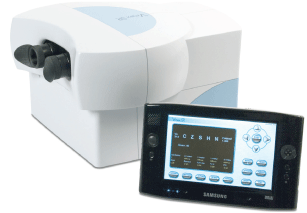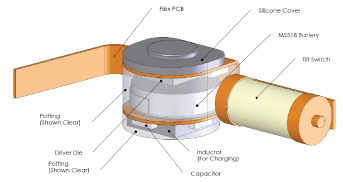 As the gatekeepers of vision care, we must always keep up on the latest optometric technologies. Our patients constantly access information about health care and medicine on the Internet, so we must be able to address their questions and concerns about potential new innovations in eye care.
As the gatekeepers of vision care, we must always keep up on the latest optometric technologies. Our patients constantly access information about health care and medicine on the Internet, so we must be able to address their questions and concerns about potential new innovations in eye care.
Recently, we have seen several new advancements in spectacle lens technology. This article previews several cutting-edge products, including VMax SR, atLast! multifocal spectacle lenses and Electronic Lens Technology.
The VMax SR (VMax Technology) can find a patients optimal refraction in minutes. Courtesy: VMax Technology
VMax SR

Still in early development, VMax SR (VMax Technology) is an advanced phoropter designed with built-in targets that can be placed in a pre-testing room or attached to the slit lamp pole. It can take measurements either objectively or subjectively and corrects refractive error down to 0.01D by measuring myopia/hyperopia, astigmatism and key higher-order aberrations via a point-spread-function target.1
The point-spread function measures the smallest resolution of a single point of light. The smaller it can be focused, the more precise a patients visual function and quality. VMax SR determines the specific refraction that creates the smallest point-spread function for a given patient. If all aberrations and refractive errors are corrected, particularly in dim and dark light conditions, the patients vision may be improved.2
With the VMax SR, you will be able to determine a patients optimal refractive correction within a few minutes. Then, you can confirm the findings objectively to ensure no overcorrection. The final release of the VMax SR system may have built-in steps to minimize, or even prevent, overcorrection.
atLast!
The atLast! (Pixel Optics) is a new multifocal spectacle lens design that incorporates patented composite lens technology to provide a continuous field of vision from approximately 14 inches to five feet.3
The atLast! lens features four viewing zones/power segments: near, intermediate (18 to 29 inches), far-intermediate (29 inches to five feet) and distance. The lens embedded power segments enhance the wearers field of vision up to 10 times more than equal add bifocals. Also, atLast! reduces zonal jump by up to 70% when patients transition through the different power segments.
Many patients who are prescribed conventional flat-top lenses essentially lose the intermediate zone of vision correction. However, atLast! provides adequate intermediate vision for cell phone and computer use, dining out or reading the gauges on a cars dashboard.
An early prototype of the microelectronic controls featured in Electric Lens Technology.
Electronic Lens Technology

In the near future, Electronic Lens Technology (Pixel Optics) may revolutionize spectacle wear. Electronic Lens Technology employs micro-electronic controls, which are located in the temple of a conventional frame, to automatically adjust add power when a patient makes a particular head movement, such as looking down to read text. This technology could practically eliminate swim, and would allow for instantaneous vision at both distance and near, with no intervention on the wearers behalf.
Electronic Lens Technology features a thin layer of liquid crystals sandwiched between two layers of transparent electrodes. These cigar-shaped liquid crystal molecules rotate in response to a mechanical change in voltage, which alters the index of refraction. Best of all, the design does not appear different than current, conventional frames and lenses.
This is an exciting time to be in optometry. New advances in spectacle lens technology will improve patient care and increase what your practice has to offer.
By staying informed about these and other promising innovations, you can provide your community with the most sophisticated eye care technology.
Dr. Karpecki is an advisor to VMax Technology and Pixel Optics, but has no financial interest in any of the products mentioned.
1. Oshika T. Quantitative assessment of quality of vision.
2. Charman WN, Chateau N. The prospects for super-acuity: limits to visual performance after correction of monochromatic ocular aberration. Ophthalmic Physiol Opt 2003 Nov;23(6):479-93.
3. Pixel Optics. atLast!the worlds first enhanced multifocal. Available at: www.atlastlens.com/pages/howitsmade.html (Accessed March 20, 2009).
4. Pixel Optics. Electro-Active Lens Technology. Available at: www.pixeloptics.com/pages/technologyelectro.html (Accessed March 20, 2009).

